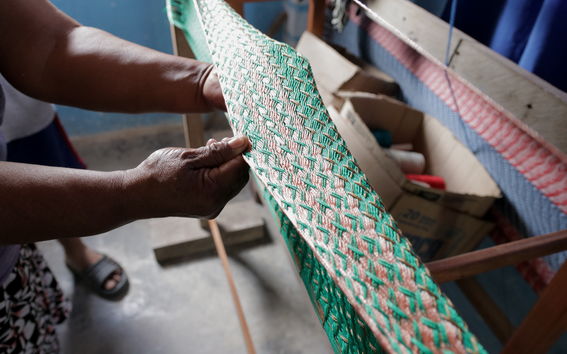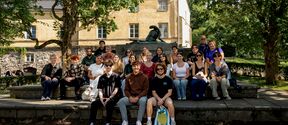Breaking the chain of vulnerability

To understand how Claudia Garduño got to where she is right now, we have to go back ten years to when she was a bachelor student in design. Each university student in Mexico must complete compulsory community service, and Garduño spent one of these periods working on a project to restore a famous mural painting. The Mexican Muralist Renaissance began in the 1920s on the heels of the revolution, making social and political topics highly visible. The Mexican government, pleased with the success of a few European-trained muralists and the international acclaim they were receiving, created a programme to train indigenous artists in the European style. One can imagine the thought that went into planning such a programme: if we bring in the well-regarded, international way of doing things, we can build upon these successes abroad. What else might happen as a consequence, no one considered.
Officials soon realized that when they taught indigenous people a certain kind of painting, some of the crafts and ways of art making they had been practicing for hundreds of years began to disappear. 'It made me question my knowledge as well,' says Garduño. 'Why would a design degree that I got in four years be more valuable than hundreds of years of tradition?'
The realization that deeper knowledge does not necessarily come from outside indigenous communities but rather from within, and that well-intended efforts to help can be condescending and even harmful to vulnerable communities, has been central to Garduño's work since then. Only she did not know it yet.
Claudia GarduñoWhy would a design degree that I got in four years be more valuable than hundreds of years of tradition?"
Her undaunting belief in the power of design to do good in the world led her to Aalto University in 2008 to pursue graduate work in design with a focus on sustainability. She was still trying to find the quintessence of her passion and work, and Aalto University was still developing its relationship to sustainability. Garduño wanted to use design to help marginalized communities in Mexico, but whenever she broached the idea to her colleagues in Finland, they would assume the collaboration would be one of designers and artisans, producing new products to be sold as souvenirs to tourists. 'It just didn't feel right to me,' she says, 'and so that's how it all started.'
What started was a commitment to people, their needs and individual lives. Garduño joined the LeNS programme, organized by Cindy Kohtula and Tatu Marttila, and AaltoLAB Shanghai. While the LeNS programme focused on building an international network of knowledge sharing and sustainability, the AaltoLAB Shanghai was something of a tabula rasa. Conceived by Tuuli Sotamaa as a marketing campaign to promote the newly founded Aalto University during the World EXPO in 2011, the programme itself was defined as a collaboration with design company IDEO Shanghai to 'put the values of Aalto University into practice for the world to see,' as Garduño explains it.
In Shanghai, Garduño and the pioneer AaltoLAB crew worked with IDEO and the first version of what would become their human-centred field guide. Working by intuition and trial and error, students from various disciplines developed a series of methods. In the field they interviewed people and observed the community, then regrouped in Shanghai together with IDEO to discuss what they had seen. What they were after was a clue how to help the people in the severely poverty-stricken region.
For Garduño, the experience opened her eyes to the realities of poverty. 'In the words of Manfred Max-Neef, you can study books and know them by heart, but you still won't know poverty until you look it in the eye,' she says.
Creating a communal identity
According to Claudia Garduño, the success of this first cohort had a lot to do with its diverse, interdisciplinary structure. 'It was the economists who saw the barley fields and thought about what might be done with them. Then someone told us there was an old glass factory in the community, too.'
Putting their observations together, the group had the idea of brewing an organic beer in the community to be distributed to the port towns in China. The proposal was well received by people, both as an economic stimulus and as a device for welding together people around a common identity. Having been created artificially during the Chinese Cultural Revolution, the community had hardly any traditions to bind them together. Brewing the beer provided a common identity.
When AaltoLAB Shanghai finished, it was uncertain whether the initiative had a future at all. Sotamaa, the programme's organizer and main proponent, left Aalto University, and plans for expansion to other countries were put on hold. Garduño reflected on the experience and her aspirations for the future. When she had sufficiently convinced herself and others of the value of the AaltoLAB project, Claudia Garduño went to Mexico and began looking into communities that could benefit from the programme.
'At first I didn't want to go to an indigenous community in Mexico,' she says, 'because I was afraid of exploiting them.' She noticed that government initiatives for assisting vulnerable communities all shared certain characteristics: they seemed oriented on urbanizing indigenous people, making populations more homogenous. Also, the very definition of poverty and how to address it was problematic. Many elements of a Mayan house such as the roof material are considered to be signs of poverty, even if the family living in the house is not actually poor.
In time, she realized that even with the best intentions, ignoring marginalized communities was also a political statement, a tacit acceptance of their marginalization. She decided to reach out to the indigenous population, selecting the Mayan community el 20 de Noviembre, named after the start of the Mexican Revolution in 1910, as the site of AaltoLAB Mexico. The community is located in Calakmul, a municipality in the state of Campeche in the Yucatan peninsula.
In the field, the first thing she noticed is that although community members faced hardship, this was not a place of abject poverty. The houses built by government initiatives largely stood empty and were used for guests, people in the community preferring their well built but modest Mayan style homes. 'Indigenous society is not based on money the way ours is,' she says. Although people in the community are happy to have the houses built (they serve as a sort of status symbol), they are impractical for daily living in a tropical environment.
Claudia Garduño'I hope that one day I can send a message and say: we did it."

Focus on the basics: water and health care
Speaking with people who live in Calakmul helps Garduño to identify the most urgent problems. Although people were happy for technological advancements - they enjoyed electricity in their homes and would appreciate piped water, neither of these amenities was at the core of people's - and the community's - needs.
Intensive conversations with community members led to the realization that water and health care were at the centre of the community's concerns, and that in some cases, health problems stemmed from water quality. 'There is very little water in the community at times, and the quality of groundwater especially is poor,' says Garduño. 'The prevalence of kidney stones could be directly related to the water situation.'
'Our economists estimate that even if people save 10 per cent of their income, it would take up to 15 years to pay off a single kidney stone operation'. As medical operations of this kind are not rare, members of the community frequently struggle to pay these kinds of debts. When debts increase dramatically, the only way to pay the debts is to sell land - the very land that is the foundation of life in the community and essential to its identity. It is a vicious cycle that Garduño calls a 'chain of vulnerability.' This is the third issue faced by people living in El 20 de Noviembre: the simple lack of income, which makes any problem that arises much more difficult to solve.
'If we could break this chain, if we could make it possible for people to go to hospital whenever they needed to, how would their lives change? I think they would flourish in a different way.'
The Calakmul project has been making great strides, including planning an ecohostel in the community to increase the inflow of money. After several years of intensive water analysis by Aalto University water engineering students, the last cohort was very diverse, which Garduño says is crucial to the programme. Still, she hopes for more.
'The community is happy to have us come back, and I know the experience has changed many students' lives. But we haven't been able to implement the really big things yet.' Garduño is optimistic that with the next round of funding, larger projects will come into reach. 'I hope that one day I can send a message and say: we did it."
Text: Lucas Millheim
More information:
***
Finland presents its exhibition Everyday Experiments at the XXII Triennale di Milano, featuring twelve experimental projects people are already doing to make their lives more sustainable and equitable. La Triennale di Milano will take place from 1 March to 1 September 2019 and is curated by Paola Antonelli, Senior Curator of Architecture and Design and Director of Research & Development at The Museum of Modern Art. Broken Nature will reflect on the relationship between humans and environments at all scales—from the microbiome to the cosmos—including social, cultural, and natural ecosystems.
Learn more about all 12 Everyday Experiments: everdayexperiments.aalto.fi
The XXII Triennale, Broken Nature: http://www.brokennature.org/
Read more news

“This hands-on approach is the absolute best way to learn” – Loyola University and Aalto University partnered for the sixth time
Isabel Towghi shares her experience from Aalto University Summer School.
Your voice gives away valuable personal information, so how do you keep that data safe?
With speech technologies becoming increasingly common, researchers want to make sure we don’t give away more information than we mean to.
Aalto in 2025: Quantum leaps, creative breakthroughs and solutions for a better life
Growth, technology and industrial renewal; human-centred solutions; health and everyday wellbeing; and enjoyable daily life and thriving communities.






